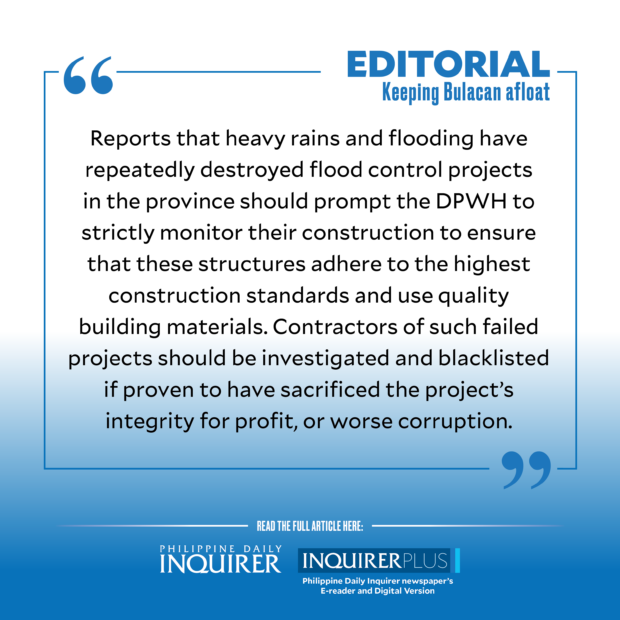Floods have become the inevitable aftermath of rains hereabouts, a predictable phenomenon during the monsoon season, especially in low-lying areas and densely populated enclaves, where waterways are often clogged with the detritus of daily living.
But because the waters usually recede in a few hours, or a couple of days at most, people have learned to adjust to flooding, with local government units preparing evacuation sites and relief packs for worst case scenarios.
Such is not the case in Bulacan, however, where floodwaters have been a constant aggravation for years, decades even, in some towns and municipalities. While Bulacan has been placed under a state of calamity following Typhoon “Egay’s” heavy rains that inundated 171 barangays and affected 228,648 families, the sub-villages of Cabu, Malindig, and Bagong Barrio in San Miguel have been living in stagnant water for more than 10 years now.
Bulacan’s topography and geographical location have a lot to do with this perennial problem. The low-lying province is a catch basin for floodwaters from nearby Pampanga, as well as runoff water from the Angat, Bustos, and Ipo dams, all located in Bulacan.
Rains, typhoons, and high tides also bring in more floodwaters, while infrastructure projects, including massive reclamation activities on Manila Bay, land conversion, fishpond development, and the construction of a mega airport in the province, have not helped any.
In 2019, maritime law expert Jay Batongbacal warned that the planned reclamation activities on Manila Bay would not only worsen flooding in Manila, but also submerge coastal villages in the provinces of Bulacan, Pampanga, and Cavite. “These projects will create a dam-like effect which [will] impede the continuous flow of water to the Bay,” Batongbacal said, referring to the rivers of Bulacan and Pampanga that drain out to Manila Bay. Meanwhile, to give way to massive infrastructure projects and construction activities, developers have been cutting down mangroves relentlessly. Aside from helping preserve biodiversity and mitigate climate change, this vital resource serves as a natural coastline protection from floods and storm surges.
Various studies have also noted that Bulacan is experiencing rapid land subsidence, or sinking because of excessive groundwater extraction, making the province even more vulnerable to flooding.
Bulacan Gov. Daniel Fernando has blamed the “mismanagement” of the three dams for the chronic and destructive flooding during typhoons, saying that their operators could have made “full coordination” with local officials before discharging water.
Clearly, a lot of interventions need to be done to mitigate the flooding in this mainly agricultural land. For one, as Fernando has noted, the national government should come up with a master plan on flood control since the province’s pumping stations have proven inadequate. And how about elevating the bypass roads that, as it is, cut through the rice fields, thus sealing off waterways that would have emptied out the floodwaters, the governor pointed out. Stricter standards on land conversion should be put in place as well, since the continuous construction of factories and huge industrial complexes have also blocked waterways and irrigation canals, Fernando said.
While structural or engineering solutions like dikes, floodgates, and culverts can reduce flooding, conservationists have suggested reforestation, watershed conservation, and land use regulations as the more sustainable and nature-friendly measures.
Above all these though is the question of accountability: How has the Department of Public Works and Highways (DPWH) spent the billions of pesos in taxpayer money allocated for flood control projects?
In December 2020, the Bulacan First District Engineering Office under the DPWH announced the start of the construction of flood control structures and three pumping stations to minimize flooding in Bocaue, as well as several road projects with a total budget of P592 million from the 2020 General Appropriations Act. Whatever happened to all that money?
Reports that heavy rains and flooding have repeatedly destroyed flood control projects in the province should prompt the DPWH to strictly monitor their construction to ensure that these structures adhere to the highest construction standards and use quality building materials. Contractors of such failed projects should be investigated and blacklisted if proven to have sacrificed the project’s integrity for profit, or worse corruption.
With Bulacan being prime agricultural land, the national government should spare no efforts to make sure that this food basket survives the disastrous aftermath of the 20 or so typhoons that visit the country annually.
Surely, with the President being the agriculture secretary as well, there’s simply no excuse to keep the province in deep water and risk food sufficiency in the process.
